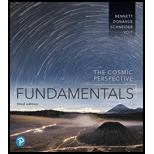
Concept explainers
Explain all answers clearly, with complete sentences and proper essay structure if needed. An asterisk (*) designates a quantitative problem, for which you should show all your work.
*21. The Lifetime of the sun. The Sun’s Mass is about 2 Ă— 1030 kg. ; This mass was about 70% hydrogen when the sun formed, with about 13% of this hydrogen available for eventual in the core.
a. Use the given data to calculate the total mass of hydrogen available for fusion over the lifetime of the Sun.
b. The Sun fuses about 600 billion kilograms of hydrogen each second. Based on your result from part a, calculate how long the Sun’s initial supply of hydrogen can last. Give your answer in both seconds and years.
c. Given that our solar system is now about 4.6 billion years old, when will the Sun run out of hydrogen for fusion?
Want to see the full answer?
Check out a sample textbook solution
Chapter 8 Solutions
Pearson eText The Cosmic Perspective Fundamentals -- Instant Access (Pearson+)
Additional Science Textbook Solutions
Concepts of Genetics (12th Edition)
Microbiology: An Introduction
Biology: Life on Earth with Physiology (11th Edition)
Chemistry: An Introduction to General, Organic, and Biological Chemistry (13th Edition)
Chemistry: Structure and Properties (2nd Edition)
Organic Chemistry (8th Edition)
- 2. A football is kicked at an angle 37.0° above the horizontal with a velocity of 20.0 m/s, as Calculate (a) the maximum height, (b) the time of travel before the football hits the ground, and (c) how far away it hits the ground. Assume the ball leaves the foot at ground level, and ignore air resistance, wind, and rotation of the ball.arrow_forwardPlease don't use Chatgpt will upvote and give handwritten solutionarrow_forwardCam mechanisms are used in many machines. For example, cams open and close the valves in your car engine to admit gasoline vapor to each cylinder and to allow the escape of exhaust. The principle is illustrated in the figure below, showing a follower rod (also called a pushrod) of mass m resting on a wedge of mass M. The sliding wedge duplicates the function of a rotating eccentric disk on a camshaft in your car. Assume that there is no friction between the wedge and the base, between the pushrod and the wedge, or between the rod and the guide through which it slides. When the wedge is pushed to the left by the force F, the rod moves upward and does something such as opening a valve. By varying the shape of the wedge, the motion of the follower rod could be made quite complex, but assume that the wedge makes a constant angle of 0 = 15.0°. Suppose you want the wedge and the rod to start from rest and move with constant acceleration, with the rod moving upward 1.00 mm in 8.00 ms. Take m…arrow_forward
- A rectangular current loop (a = 15.0 cm, b = 34.0 cm) is located a distance d = 10.0 cm near a long, straight wire that carries a current (Iw) of 17.0 A (see the drawing). The current in the loop is IL = 21.0 A. Determine the magnitude of the net magnetic force that acts on the loop. Solve in N. a b IL Iwarrow_forwardTwo long, straight wires are separated by distance, d = 22.0 cm. The wires carry currents of I1 = 7.50 A and I2 = 5.50 A in opposite directions, as shown in the figure. Find the magnitude of the net magnetic field at point (B). Let r₁ = 12.0 cm, r2 = 7.00 cm, and r3 = 13.0 cm. Solve in T. 12 d A √3arrow_forwardI tried to solve this question, and I had an "expert" answer it and they got it wrong. I cannot answer this questionarrow_forward
- Eddie Hall is the current world record holder in the deadlift, a powerlifting maneuver in which a weighted barbell is lifted from the ground to waist height, then dropped. The figure below shows a side view of the initial and final positions of the deadlift. a 0 = 55.0° Fift h22.5 cm i hy = 88.0 cm b iarrow_forwardsolve for (_) Narrow_forwardTwo boxes of fruit on a frictionless horizontal surface are connected by a light string as in the figure below, where m₁ = 11 kg and m₂ = 25 kg. A force of F = 80 N is applied to the 25-kg box. mq m1 Applies T Peaches i (a) Determine the acceleration of each box and the tension in the string. acceleration of m₁ acceleration of m₂ tension in the string m/s² m/s² N (b) Repeat the problem for the case where the coefficient of kinetic friction between each box and the surface is 0.10. acceleration of m₁ acceleration of m₂ tension in the string m/s² m/s2 Narrow_forward
 Physics for Scientists and Engineers: Foundations...PhysicsISBN:9781133939146Author:Katz, Debora M.Publisher:Cengage Learning
Physics for Scientists and Engineers: Foundations...PhysicsISBN:9781133939146Author:Katz, Debora M.Publisher:Cengage Learning AstronomyPhysicsISBN:9781938168284Author:Andrew Fraknoi; David Morrison; Sidney C. WolffPublisher:OpenStax
AstronomyPhysicsISBN:9781938168284Author:Andrew Fraknoi; David Morrison; Sidney C. WolffPublisher:OpenStax Glencoe Physics: Principles and Problems, Student...PhysicsISBN:9780078807213Author:Paul W. ZitzewitzPublisher:Glencoe/McGraw-Hill
Glencoe Physics: Principles and Problems, Student...PhysicsISBN:9780078807213Author:Paul W. ZitzewitzPublisher:Glencoe/McGraw-Hill Horizons: Exploring the Universe (MindTap Course ...PhysicsISBN:9781305960961Author:Michael A. Seeds, Dana BackmanPublisher:Cengage Learning
Horizons: Exploring the Universe (MindTap Course ...PhysicsISBN:9781305960961Author:Michael A. Seeds, Dana BackmanPublisher:Cengage Learning Foundations of Astronomy (MindTap Course List)PhysicsISBN:9781337399920Author:Michael A. Seeds, Dana BackmanPublisher:Cengage Learning
Foundations of Astronomy (MindTap Course List)PhysicsISBN:9781337399920Author:Michael A. Seeds, Dana BackmanPublisher:Cengage Learning





